I've been told by well-meaning individuals that I should charge for my "research"--but since that is an utterly unrealistic way to make a living, I'll keep my day job and instead give you the following "trade secrets" free of charge. I welcome any corrections or suggested changes.
1. Find your Pre-1921 Address

For most of Detroit's history, the city had no organized street address system. The first house on a street closest to the Detroit River or Woodward Avenue was simply numbered "1". Since all streets obviously do not begin at the same point, confusing discrepancies resulted. Around the block from 75 Leverette, for example, was 31 Church Street--which in turn was one block south of 455 Michigan Avenue. After the reformed numbering system went into effect on January 1, 1921, all three of those addresses became 1519 on their respective streets.
The easiest way to find out your house's previous address is to look it up in the 1920-1921 city directory. The Burton Historical Collection at the Detroit Public Library has a six-volume re-print of this directory. The back of the directory contains a list of all of the addresses by street name--both new and old--and the name of the head of the household. This reverse-address portion of the 1920-1921 directory runs from page 2357 in volume five to page 2807 in volume six.
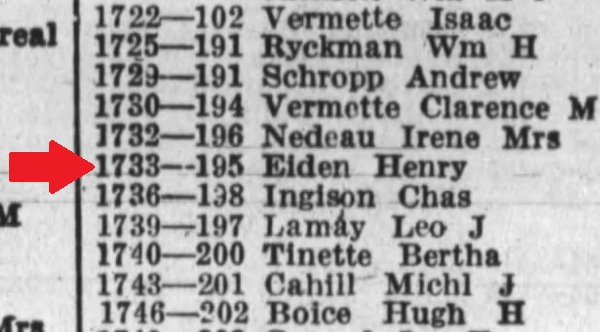
The example above indicates my previous home at 1733 Wabash. In this directory, the new address is always listed on the left, and the old one is on the right. 1733 Wabash was previously 195 Wabash, and the occupant in 1921 was Henry Eiden.
It is also important to remember that many of Corktown's streets changed their names at some point in their history. Much of Michigan Avenue outside of downtown used to be known as Chicago Road. Leverette Street used to be spelled "Leverett". Below is a list of Corktown streets with their old names and the year in which the change occurred.
- Bagley (c. 1930) - Baker (south of Michigan Ave only)
- Brooklyn (1898) - Seventh
- Cochrane (c. 1962) - National
- Fifteenth (1867) - Lafontaine
- Fourteenth (1867) - Godfroy
- Rosa Parks Blvd. (1976) - Twelfth (1867), Thompson
- Temple (1921) - Bagg
- Tenth (1867) - Dudley (Below Church St.; above Church was Wesley until c. 1890s)
- Trumbull (1876) - Ninth
- Vermont (1904) - Thirteenth (1867), Lafferty
- Wabash (1882) - Thirteenth and-a-half (1868), Peter
2. Search the City Directories

Now that you have your pre-1921 address, you can find out who previously lived in your house using the other city directories at the Burton Historical Collection. All of the directories from 1888 onward have the same reverse address lookup that the 1921 directory did. You can begin with 1921 and work your way backward, or start with the earliest date you knew your house existed and work forward. Directories were not printed during World War II, and the library's collection of directories after that point is very sporadic.
Don't just write down the name that appears by your address in the back section of the directory. Once you have that name, look it up in the main body of the directory. That listing will provide the individual's full name and occupation. It is also possible to spot other adult family members living at the same address. Sometimes the directory will list other useful information, such as when an adult city resident died or moved to another city.
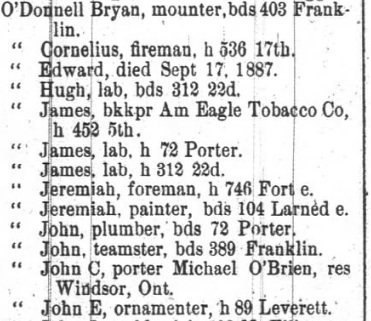
A sample from the 1888 directory.
Common abbreviations used in the city directories include:
- bds - boards
- clk - clerk
- collr - collector
- h - house; appears after the head of household
- lab - laborer
- mach - machinist
- r - rear, for small homes built on the alley side of a property
- rms - rooms
- wid - widow
Your access to the Burton Historical Collection may be complicated by anything from your personal schedule to the fact that you don't have a library card because you lie about where you live to get cheap car insurance. An alternative to visiting the Detroit Public Library is the genealogical website Fold3.com, which has searchable images of the directories from 1861 to 1923 accessible here:
http://www.fold3.com/browse.php#11|hOKBe_5Qx
The site costs money, but you may be eligible for a free trial. I find it easier copy the information from the directories at the library, and then use Fold3.com to search for the information I could not find there. Their search function is not perfect, but invaluable once you become familiar with its idiosyncrasies.
3. Obtain the Legal Description of Your Property

Before Corktown was a neighborhood, the land consisted of ribbon farms, the boundaries of which were originally drawn the government of New France. As Detroit expanded and the land became too valuable for farming, the landowners divided their property into blocks of private parcels and then sold them off. The legal description of a home in Corktown commonly contains the name of the farm (or at least whatever name given to that subdivision), the block number, parcel number, whether it is only part of a parcel (they are often divided in half), and its dimensions.
If you own your home and are a good record keeper, then you should be able to find the legal description of your property on a tax bill, a tax statement, the deed to your house, or in your original mortgage paperwork. The less circumspect among you who have lost track of these documents--presumably crumpled and stained with coffee rings the last time you saw them--can still find this information online.
Go to waynecountylandrecords.com and click on "Search Real Estate Index". Type in the last and first name of the property's current owner and click "Search". Find a listing that is associated with your property and click on the link that appears under "Instrument #". You will then come to a page that looks like this:
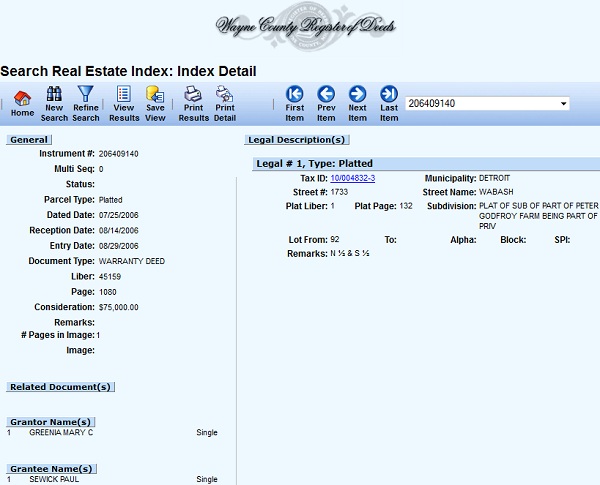
Click on the link next to "Tax ID". That should bring a popup window that looks like this:
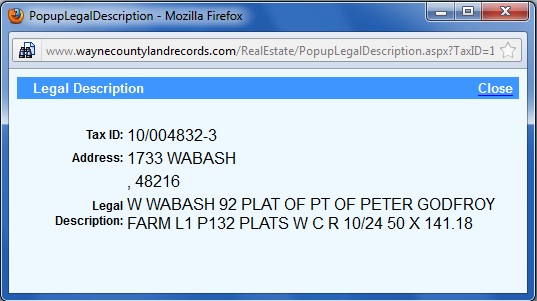
The lines of text following "Legal Description" are exactly what you need. This example describes the Bechstein House at 1733 Wabash. Here is a breakdown of what this particular legal description means:
- W WABASH - West side of Wabash Street
- 92 - Lot number 92
- PLAT OF PT OF PETER GODFROY FARM - Plat of Part of Peter Godfroy Farm. This is technically the name of the subdivision. By the time Corktown was platted, the ribbon farms had reached three miles long, resulting in many subdivisions that contain the name of a particular farmer.
- L1 P132 PLATS W C R - As recorded in liber/book 1, page 132 of plats (subdivision plans) of the Wayne County Register
- 10/24 - I'm not going to lie. I do not know the significance of this number. I'm an amateur blogger, not a lawyer.
- 50 X 141.18 - The lot measures 50 feet by 141.18 feet. Fractions of a foot are usually written in decimals and not inches.
Legal descriptions don't necessarily follow this exact format. They often also include a block number and describe the parcel as comprising only a portion of the original lot. For another example:
N BAGLEY E 56.56 FT OF 8BLK 57 LABROSSE FARM L13 P85 DEEDS, W C R 6/6 56.56 IRREG
This describes the Buchanan House at 1242 Bagley and translates to: "North side of Bagley, the east 56.56 feet of Lot 8, Block 57 of the Labrosse Farm as recorded in Liber 13, Page 85 of Plats by the Wayne County Register." The parcel is not a neat rectangle, but an irregular shape that measures 56.56 feet wide.
Do not skip this step. You will need this information in order to complete several steps below.
4. Find a Plat Map of Your Property

When the ribbon farm owners divided and sold off their land, they could not draw up new divisions at their discretion. They had to hire civil engineers to draw out plans in accordance with the law, including allowances for public rights-of-way such as streets and alleys.
The State of Michigan has made copies of these plans available free of charge on the following site (note: you must have Java installed for this site to work):
http://www.dleg.state.mi.us/platmaps/sr_subs.asp
Finding the map you're looking for can be tricky. The subdivision name attached to the map probably won't be verbatim what appears in your legal description, but it's good to start with the last name of the original farm owner. It is helpful to be very familiar with the layout of the streets immediately surrounding your property before browsing these maps. Also refer to the previous list of street names that have been changed. Property owners tended to submit plans with streets named after themselves, and the city would subsequently rename them.
Below is an example of what you should find--a drawing of the lots, streets, and alleys with a lot of legal language written next to it. This plat is for the portion of the Woodbridge Farm (approximately between 8th and 10th Streets) south of Michigan Avenue.
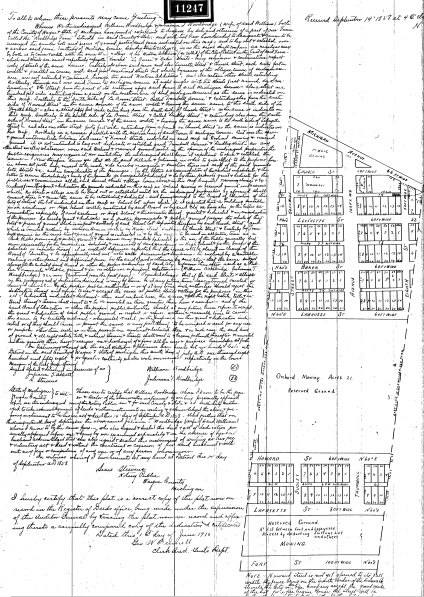
Unfortunately, there is no way to conveniently download the maps. Normally I will zoom in on an area I want to save and take a screenshot.
The maps will indicate block and lot numbers, and you should have no trouble identifying your property if you know its legal description. The legal writing might yield helpful information, such as the date that the plat was submitted to the county, the name of the civil engineer who drew the plans, etc.
5. Obtain Copies of Past Deeds

Combing through the city directories has only provided you with the names of the past occupants of your home, but without a way to know whether those individuals were owners or renters. In order to establish a chain of ownership from the time your property was platted to the present day, you need to obtain copies of all past deeds from the Wayne County Register. I recommend that you request just the first page of each deed, since it will contain all of the information you need. You also have the option of obtaining copies of mortgages and other documents associated with the property, but they are not necessary to determine past ownership. Decide ahead of time how far back you want the search to go. I prefer starting with the year the local subdivision was platted.
Your request for copies of deeds can be done either in person at the Wayne County Register's office or through the mail. In order to make a request in person, go to the 7th floor of 400 Monroe Street in Greektown. When you find the Register of Deeds office, take a numbered ticket from the area for Search and Copy Services. Be sure to bring with you the legal description of your property and at least $5.00 in the form of cash or a money order to perform the search. When your documents are ready (which could take weeks), you will owe an additional $1.00 per page for all of the documents that the search yields.
Searching by mail costs $15.00 up front. This fee includes the first five pages of documents, with additional pages costing $1.00 each. There is no way to know what the total cost will be. One house I researched had so few past owners that the deeds cost only $15.00--others have totaled nearly $50.00.
I find mail searches to be more convenient. Below is a sample request letter.
Wayne County Register of DeedsThe clerks at the county register do not photocopy actual paper deeds when collecting your requested documents. All of the deeds have been photographed and the images are stored on microfilm. What you receive will be printouts from their microfilm machine, the legibility of which can vary. The good employees of Wayne County will usually print out a page at different levels of exposure in order to make sure you can read the entire document, but only charge you for the one copy.
400 Monroe Street, 7th Floor
Detroit, MI 48226
Subject: Search & Copy Request
Madam/Sir:
I would like to request copies of the first page of each deed on the following address going back to the year [XXXX]:
[FULL ADDRESS]
[FULL LEGAL DESCRIPTION]
I need a record of every transfer to establish a chain of ownership from [YEAR] (the year the [XXXXXXXXXX] Farm was platted) to the present day. I only require copies of deeds (first pages only) and not mortgages.
Enclosed is a $15.00 money order for the search fee and first five pages of copies. Feel free to contact me at (XXX) XXX-XXXX with any questions.
The most recent deeds on your house will be neatly typed and easily readable. Depending on how far back in time you search, you might also end up with handwritten, 200-year-old pages like this:
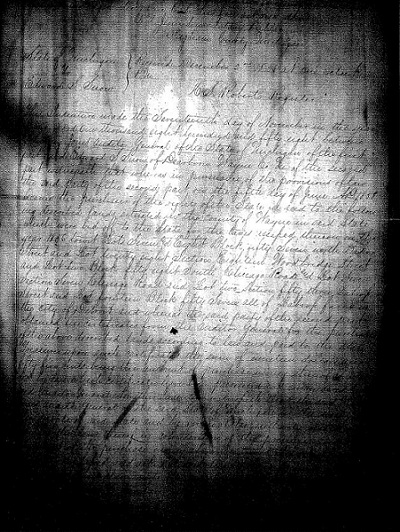
Do not despair when attempting to decipher barely-legible legalese. I advise you to take your time and carefully transcribe documents like this in full. If you're like me, you might have to frequently look up words like "remise" and "appurtenances". I'm still not even sure what those mean.
6. Search the Building Permit Index

For this step you will need to have at least a rough idea of when your house was built. Hopefully your research into the city directories has given you something to go on (e.g., you kept going backward in time until the address just stopped appearing).
For homes built before mid-1880:
You're out of luck. Building permits simply were not required at this time. I guess by 1880 the free market by itself had failed to supply the people of Detroit with safe housing.
For homes built between 1880 and 1908:
The building permit indexes are available on microfilm at the Burton Historical Collection at the Detroit Public Library. Certain series of microfilm reels are given a collective record number. The series you will need for this time period have been designated BHC # 960. Each roll of film contains images of the pages of several separate volumes of building permit indexes. The contents are as follows:
REEL 1
- Vol. 1. 1880-1882
- Vol. 2. 1882-1885
- Vol. 3. 1885-1887
- Vol. 4. 1887-1889
REEL 2
- Vol. 5. 1890-1891
- Vol. 6. 1892-1893
- Vol. 7. 1894-1897
- Vol. 8. 1898-1901
REEL 3
- Vol. 9. 1902-1904
- Vol. 10. 1905-1906
- Vol. 11. 1907-1908
REEL 4
- An index to the building permit index.
Begin with Reel 4. It is an index of building permit dates arranged by address. The beginning of the reel is missing, but Baker Street and the rest of Corktown should still be intact. When you find the street you're looking for, the page will contain only addresses and dates. (Please note that numbered streets are spelled out--e.g., 12th Street appears as "Twelfth" and is alphabetized accordingly.) Because permits are listed chronologically and not by house number, you will need to go through the pages line by line to find the address you are looking for. When you find your house number, write down the date next to it.
Note: Addresses are frequently misnumbered. More than once I have found the right permit only by looking under the "wrong" number. 89 Leverette was labeled 91, and 20 Baker street appeared as 18. (I confirmed that I had the right houses based on the lot and block numbers, which are included in the building permit index.) The builder or architect pulling a permit might have had an idea of what the house's address would be based on its location, but for whatever reason this may have changed by the time the home was actually built. This is one instance in which knowing your property's legal description is essential.
Now that you have a specific date to look up, load whichever reel (from 1 to 3) that corresponds to the date you are looking for. As I've mentioned, each reel contains several volumes of handwritten indexes. For example, volume one on reel one lists the building permits in chronological order from mid-1880 to mid-1882. After the normal permits, that same volume will then list the permits for alterations and additions to existing structures for the same time period. This is followed by volume two: permits for new structures from 1882 to 1885, and then permits for alterations and additions within that same date range. When scrolling through the film looking for a specific date, pay attention to the heading at the top of the page. More than once I've gotten confused and wasted time searching for a date only to realize that I didn't advance the film far enough and was still in the permits for additions from the previous time period.
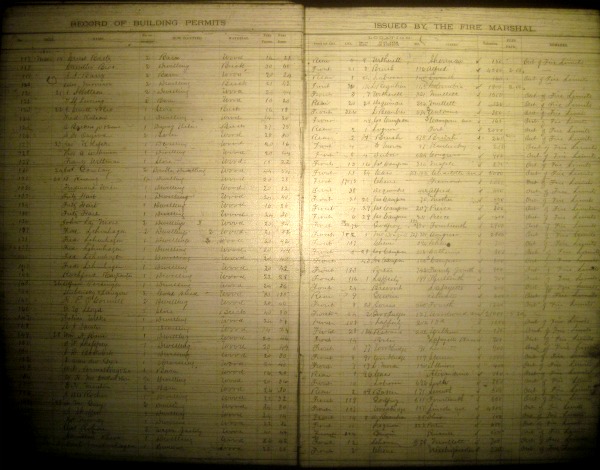
Each entry in the building permit index contains the following information: permit number, date, the individual to whom the permit was issued (not necessarily the owner, but possibly the builder or architect), the number of stories in the structure, the type of structure (dwelling, store, church, etc.), composition, dimensions, location on the lot, lot and block numbers, farm or subdivision name, street address, and estimated cost of construction.
Unfortunately, permits for alterations and additions are not indexed. If you know for a fact that your home had an addition built in a specific time period, and you are determined to locate the details in the index, be prepared to search through hundreds of lines of fading, handwritten entries.
For homes built between 1909 and 1924:
The indexes to building permits for this time period are also held at the Burton Historical Collection. They are only available in bound volumes, and not on microfilm. They are in six volumes and organized by street name:
City of Detroit - Index to Building Permits 1909-1924
- Vol. 1. A - Central
- Vol. 2. Chalfonte - F
- Vol. 3. G - Lawton
- Vol. 4. Lawton - Paulus
- Vol. 5. Pearl - Townsend
- Vol. 6. Traverse - Zug
There is no index to this index, and both permits for new structures and for additions are mixed together. To find your address you will need to search the pages for your street line by line. These entries contain less information than the older index. These data include the permit date, street address, composition, type of structure, permit number, whether the permit is for an addition or structural moving, and lot number.
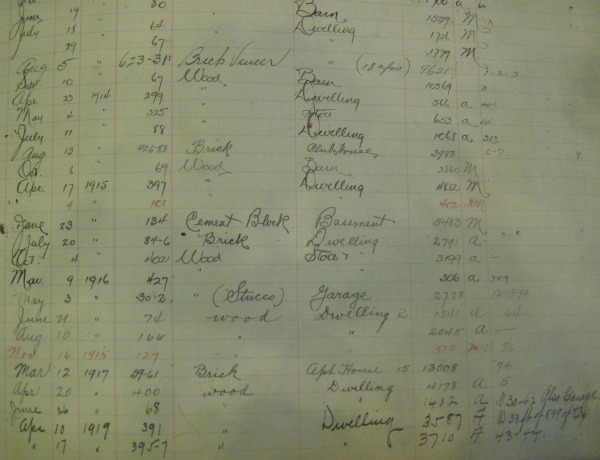
A page from the permits for Ash Street. The Cymbre Apartments
are indicated on the fifth line from the bottom.
It is possible to view copies of the actual building permits on microfilm at the City of Detroit's Historic Designation Advisory Board Office in room 204 of the Coleman A. Young Municipal Center. Contact the office at (313) 224-3487 to schedule an appointment with Deborah Goldstein, and be sure to bring with you the building permit number and the rest of the information contained in the building permit index. Their microfilm machine displays very small images, so I would advise you to take digital photos of the display with a steady hand and enlarge them on your computer. Below is an example of a building permit for a 1917 apartment building in North Corktown. Whether or not the amount of information it contains warrants the inconvenience, I leave up to you.
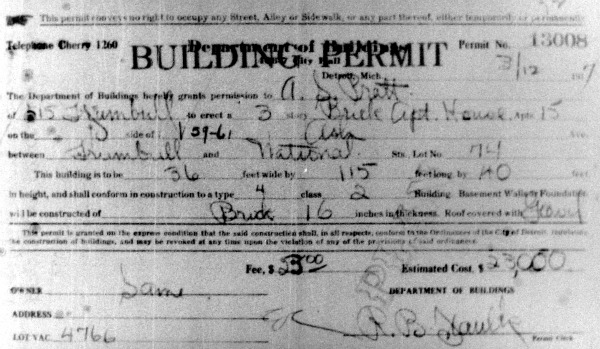
Permit to construct the Cymbre Apartment Building, 1533 Ash Street.
For homes built after 1924:
You will need to contact the City of Detroit at:
Permit Information CenterThanks to Allan Machielse for informing me of the 1909-1924 permit index and the process for obtaining permit copies from the Historic Designation Advisory Board!
Buildings & Safety Engineering Department
4th Floor, Coleman A. Young Municipal Center
Detroit, MI 48226
(313) 224-2733
7. Locate Your Property in Real Estate Atlases

Real estate atlases are highly detailed maps that show the outline of every man-made structure in the vicinity. They are useful in determining whether or not additions have been made to a structure and what types of buildings stood nearby that may no longer exist. Larger buildings such as churches and factories are labeled and described, and color-coded versions indicate the kinds of building materials used for all structures.
If your home was standing in Detroit in 1885, then it should appear in Elisha Robinson's Atlas of the City of Detroit and Suburbs. The maps in that atlas are available free of charge online as either color JPGs or black-and-white PDFs. Corktown and North Corktown are covered from pages 44 to 65.
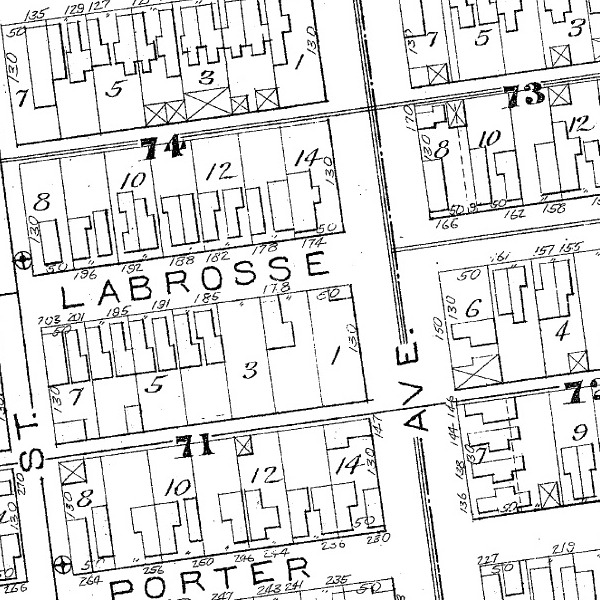
An even greater level of detail can be found in the Sanborn Maps, although they are not as conveniently accessible. Sanborn Maps of the Corktown area are available for 1884 (1889 west of 12th Street), 1897, and 1921. The 1921 edition is especially useful because it displays both the old and new addresses for each structure.
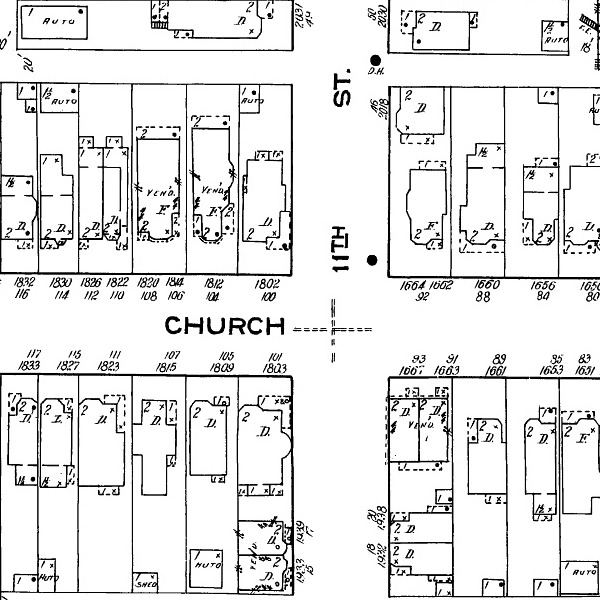
The Sanborn Maps can be accessed free of charge through any computer terminal with internet access at the Detroit Public Library. From their website, click on "Research & Resources". Under Databases, click on "Maps" and then "Digital Sanborn Maps". When you find a map you need, it is possible to download it in the form of a PDF. The file may have a name like this: Detroit+1884-1899+vol.+1,+1884,+Sheet+15_a.pdf Keep in mind that the last year displayed in a file name is the edition in which the map appears.
You might also find DTE's aerial photographs of Detroit from 1949 to 1997 to be useful in your research.
8. Search Photo Archives
 Image Courtesy of the Burton Historical Collection, Detroit Public Library
Image Courtesy of the Burton Historical Collection, Detroit Public Library
• The Detroit Urban Conservation Project
In 1976, the State Historic Preservation Office photographed buildings in historically significant areas of Detroit as part of the Detroit Urban Conservation Project. If your Corktown home or commercial building stood in 1976, it was photographed. I found out (again from my friend Allan Machielse) that the film negatives for these images were kept at the City of Detroit's Historic Designation Advisory Board Office. The staff very graciously allowed the negatives to be scanned and the images to put posted online for free distribution. They can be accessed here:
http://www.flickr.com/photos/corktownhistory/sets/72157628099965522/
The available images at the site above are almost exclusively from the Corktown historic district. Only a handful of North Corktown photos have been scanned and posted.
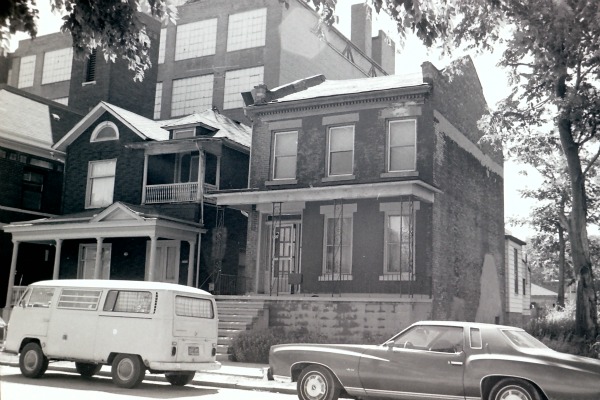
1227 Bagley in 1976. Compare to a modern image.
Courtesy of the State Historic Preservation Office of Michigan.
Although these images are only 36 years old, they are valuable documentation of both the improvement and deterioration of many homes, as well as perhaps the only surviving images of structures that have since been demolished.
•The Burton Historical Collection
The Burton Historical Collection contains thousands of historic photographs, including streetscapes and images of houses indexed by street name. The attending librarian can show you how to search the index and request the folder for a particular street. You are free to make a photocopy of the images or photograph them with a digital camera, but digitally scanning them entails fees which vary according to your intended use.
However, the University of Michigan has made available over 12,000 digitized images from the BHC online. The archives can be searched on the following page:
http://digitalcollections.detroitpubliclibrary.org/
The odds of finding a historic photograph of your house in this collection are very low. But exploring a 125-year-old photograph at full resolution taken even just a few blocks away from your house is the closest you can get to traveling back in time.
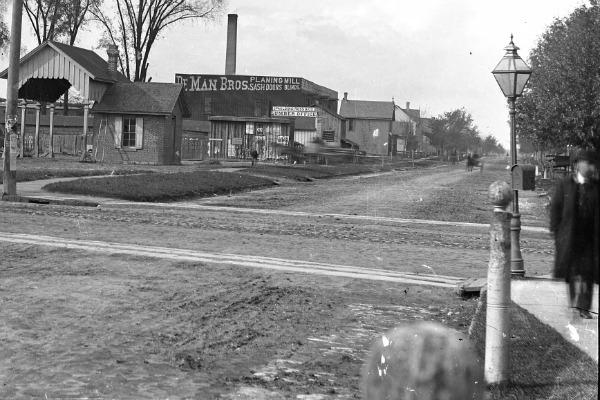
The northwest corner of Michigan and Trumbull, c. 1880.
Courtesy of the Burton Historical Collection, Detroit Public Library (Source)
• Virtual Motor City
These photographs, originally from the archives of The Detroit News, are now held at the Walter P. Reuther Library at Wayne State University. The archive is searchable through the following link:
http://dlxs.lib.wayne.edu/cgi/i/image/image-idx?page=index;c=vmc
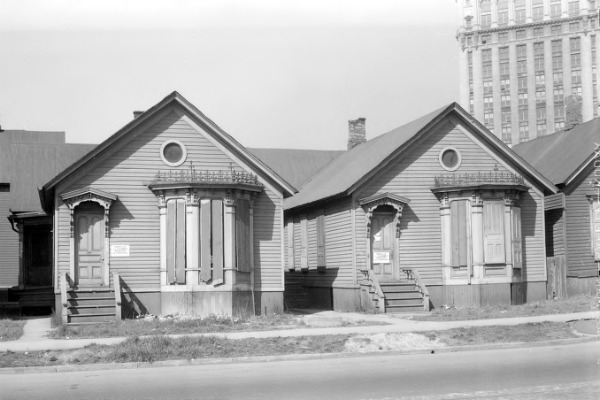
Homes on 14th Street by Marantette in 1935, now demolished.
Image courtesy of Walter P. Reuther Library, Wayne State University. (Source)
Most of the images are from the 20th century, but the collection is important for anyone interested in local history.
• 1954 Photographs
In 2011 my neighbor Scott Robichaud (of the blog Redemption in Corktown) obtained 146 photographs of Corktown homes taken in 1954. They appear to have been part of a presentation advocating historic preservation over demolition in the name of urban renewal. It seems that most of the homes photographed have since been demolished. Scott has scanned, labeled, and uploaded the images, which can be viewed and downloaded here:
http://www.flickr.com/photos/corktownhistory/sets/72157628093919480/
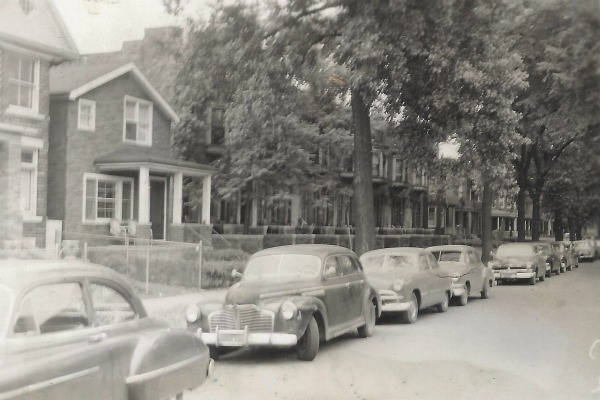
South side of Leverette Street, west of 10th Street, c. 1954.
9. Search the Historical Detroit Free Press Archives

Searchable images of the Detroit Free Press from 1831 to 1922 are available free of charge to any holder of a Detroit Public Library card. Unlike the Sanborn Maps, these records can be accessed on your home computer. From the DPL's website, click on "Research & Resources." Under "Databases", click on "Newspapers", then "ProQuest Historical Newspapers: Detroit Free Press (1831-1922)". You will need to enter your library card number.
Search for everything you possibly can! Search for your "old" address, your street name, nearby cross streets, the names of previous occupants of your home, the names of previous owners, the name of the builder--anything you can think of. When researching the Joseph Kingston House on Bagley, I found in the Free Press archives a very entertaining story about his divorce case. It was also in these records that I found a detailed account of the first occupant of the O'Donnell House being brutally attacked on the job just two months after joining the Detroit Police. Even a minor find can be a lead to much more important information.
Of course, the search function has its own idiosyncrasies. The database, for example, might read "Patrolman" in a headline as "Petrolman", and therefore searching for "patrolman" will not bring you to that article. Read the site's search tips and try an advanced search in order to find what you're looking for.
UPDATE: There is now a paid website where you can access digitally searchable Detroit Free Press archives from 1831 to the present day. It is accessible at freep.newspapers.com, and well worth the money!
10. Utilize Genealogical Records

If you are interested in learning more about the people who once lived in your house, you will need to exploit any available genealogical resources. I recommend starting a family tree on Ancestry.com explicitly for your house research. Building family trees on that site is free, but access to their records requires a paid membership. There is also a free version that can be accessed on the computer terminals at the Detroit Public Library.
Perhaps the most important genealogical resources are the U.S. Federal Census records. Unlike the city directories, the censuses have recorded the names of every man, woman and child in every household.
The census can also reveal connections between people whose names you already know from other sources. For example, someone performed research on the Bechstein House on Wabash before I lived there. The description that was provided noted that Frederich Bechstein, the first owner and supposed builder of the house, sold it to a woman named Lena Eiden, wife of Henry. One day I looked up their names in the 1900 census:

It lists Henry Eiden, his wife Lena, and their children. I was surprised to see that Frederich Bechstein, then 74 years old, was still living in the home. It listed his relationship to the head of the household as "father-in-law". Lena was his daughter--an important fact that the previous researcher apparently was not aware of!
Federal Census records are available for every year ending in zero until 1930. In a matter of days, the 1940 census will be released to the public. The only year missing is 1890, which was lost in a fire in 1921. Slightly different data were recorded each year, but they generally included an individual's name, age, race, marital status, occupation, country of origin, and birthplace of parents. Although the censuses from 1880 onward include the household address, they are only searchable by the individuals' names.
There is not enough space here to adequately cover the ways that genealogical resources can help you learn about your home's past occupants. The best I can do is urge you to get started and give an idea what what you might find. At the very least, you can generally expect to uncover the three most important dates in the lives of those who lived in your home: their births, marriages, and deaths. Some people have no interest in such boring statistics. For me personally, when I know that these events occurred in my home and in the homes of my neighbors, and that the joyful and tragic moments of their lives unfolded in the very same wood-framed houses where our own daily lives play out, then I believe that our shared experiences connect us to those who came before us almost as closely as our own ancestors.
I have found these other resources to be helpful:
- FamilySearch.org - This is an excellent source of data that covers much of what Ancestry.com lacks. In particular, it contains indexes of Michigan marriages through the 1920s.
- SeekingMichigan.org - This website contains images of all Michigan death certificates from 1897 to 1920.
- The Detroit Death Index - A record on microfiche of the names of individuals who died within the city limits of Detroit from 1920 to 1988. It contains the individual's name, date of death, and age at the time of death.
- The Burton Historical Collection Biographical Index - This collection contains thousands of obituaries and other newspaper clippings on everyday Detroiters as well as prominent citizens.
- Local Cemeteries - Although some mind find this morbid, I feel it is appropriate when renovating or researching a historic home to pay one's respects at the final resting place of its previous residents. It is also an opportunity to experience the beauty and serenity of Detroit's historic cemeteries.
Thanks to Christopher Holt for introducing me to genealogy and patiently answering my innumerable questions over the years!
